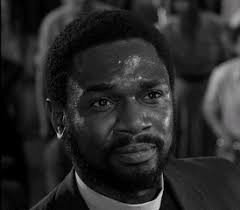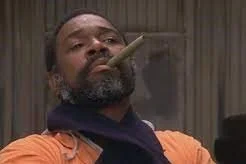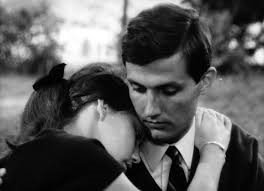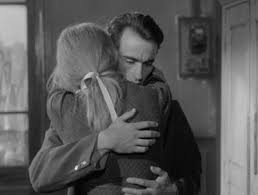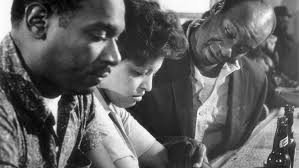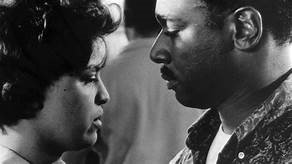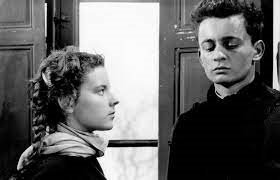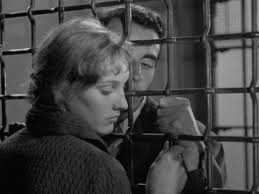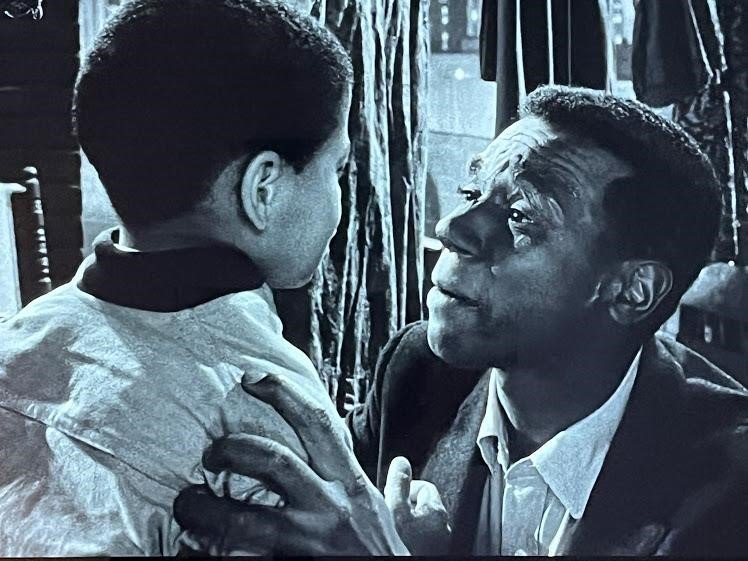IVAN DIXON: Hollywood’s Lonely Radical pt. 1: The Actor
Ivan Dixon and Abbey Lincoln in Michael Roemer’s Nothing But a Man
"Even among black directors today – and I'm not saying these guys haven't done good work – there is more concern with making movies that make money, that titillate and get people to the box office...And I think that is the kind of horror of Black American life that we have accepted that struggle for the dollar instead of struggling for humanity. For honor."
- Ivan Dixon, as quoted in New York Newsday newspaper, 1993
Duff is one of the most touching creative performances ever given by an American actor. “It was me,” Dixon said.
Ivan Dixon (1931-2008) was the star of Michael Roemer's 1963 independent film Nothing But a Man, which Malcolm X cited as his favorite film, and director of the politically and aesthetically revolutionary cult classic The Spook Who Sat by the Door, ten years later. By 1967, he gained widespread popularity due to his role as Sgt. Kinchloe in Hogan's Heroes, a sitcom he detested.
My aim here is to focus on his approach and execution as both actor (part one) and director (part two) and explore how his personal style of acting and directing in the screen work he would have deemed worthy - was congruent to and exemplary of his political ideology and moral concerns and this makes up a marginalized, but essential, basis for a conscientious, and radical form of motion pictures.
*
The film critic Jonathan Rosenbaum once offered a casual theory about some of cinema's greatest filmmakers being triple threats (actor-writer-directors like Charlie Chaplin, Orson Welles, Elaine May, etc) who absconded and derailed the traditional "storytelling" approach to movies that born-in-the-bone film directors possess. Some of our greatest and most underrated contemporary filmmakers are actor-writer-directors (Robert Townsend and Wendell B. Harris, for example) whose use of film as a narrative form and personal excavation of our social world and political turmoil is relayed through their innate impulse as performing artists first, arguably, and montage-makers second. Although not a noted writer, Ivan Dixon is among one of the most mysterious and intriguing auteur performer-filmmakers of the twentieth century. Let’s reflect on what he did as a performer on screen.
Best known to the mainstream as Sgt. Kinchloe on “Hogan’s Heroes”, a TV show he detested, Ivan Dixon is one of our most mysterious, interesting and underrated cinema icons.
The Actor
As Reverend Anderson (Left) in Twilight Zone’s “I am The Night Color Me Black” (1964) and as Lonnie in Michael Schultz’s Car Wash (1976). Dixon was one of the first actors, Black or White, on the American screen to don a beard and hone a persona with it. Until the 1970’s beards were extreme symbols of the counterculture and the working class. His insistence to retain his mustache in 1963’s Nothing But a Man was revolutionary in and of itself.
Ivan Dixon’s unwavering coolness as an actor that gently lent itself to a powerfully nonchalant radical stance is the basis for everything he ever did of worth on screen. The best of these performances have gravitas and a consciousness that never comes off as shrill or patronizing. They are seen as necessary. His later memorable performance as Lonnie in Michael Schultz’s Car Wash - is unintentionally a riff and acknowledgment of the entire catalog of Dixon’s best performances. From his Twilight Zone showcase (1960, season one’s The Big Tall Wish) as Bolie, a washed up boxer whose career is predicated on a boy’s wish, to his work in 1962’s highly-praised Cain’s Hundred TV program episode “Blues for a Junkman” (with Dorothy Dandridge) to the railroad worker Duff in Nothing But a Man (to the later political exasperation of his directing coup The Spook Who Sat by The Door) his work culminates in the haggard beauty of Lonnie; his acting trajectory up until then informs this character’s ornery nature.
He did play a guerrilla doctor in "Amerika", a 1987 TV series set amidst an imaginary Russian invasion of Nebraska. American TV’s cold war paranoia ironically provided one last opportunity for Dixon to flex his radicalism as an actor before he excused himself from the dinner table and went to Maui where he retired completely from acting and later sold off his radio station in 2002.
*
Harlem has so many mysteries. One day an anthropologist will mine the addresses, birth certificates, and provenances of some of the twentieth century’s most interesting artists and it will reveal, with shocking clarity, how many of the most unique Black performing artists and thinkers had their genesis in Harlem. Like another Wavelengths luminary from Harlem featured in the past year, Billy Dee Williams, Ivan Dixon, too, was from this 'Bethlehem'. In fact, Dixon grew up on the same block Ralph Ellison and Gregory Hines lived on (518 West 150th Street!).
But unlike Billy Dee Williams’ early proclivities for creative expression, Dixon, like too many boys in precarious circumstances on the fringes of the working poor, became a juvenile delinquent by his early teens and was, in fact, exiled by a NYC judge who demanded either Dixon leave NYC or become a prisoner of it in a reform school.
His mother immediately made arrangements and sent him to North Carolina’s Lincoln Academy. At this boarding school he gained a different perspective on life and was able to mature and grow in ways that he probably would not have been able to had he stayed with the riff-raff who always got him into trouble. In a 1967 TV Guide magazine interview, he states he most likely would have become a numbers runner in Harlem had he not left for North Carolina.
● SIDNEY POITIER AND DIXON’S BIG BREAK
Dixon’s first break in the movie industry was as Sidney Poitier’s stand-in. Poitier, love him, hate him, dismiss him – one can’t escape him. All roads lead to Poitier. The way Hip-Hop can’t escape James Brown or psychological realism in acting can’t quite shake the dust of Stanislavski. Poitier has had such an impact on actors alone, it’s almost taken for granted. Whereas Brando and Dean may have galvanized a generation culturally and artistically even, Poitier’s contribution to the public sphere was seismic for Black actors who not only saw themselves - but what they also could be - in Poitier. They knew that they too had a depth and intellectual rigor that needed to be shared and recognized. There is life before Poitier and life after. And while there is enough room for criticism of his professional choices post 1970 and later pathological admiration for people like Quentin Tarantino (a sin in my book), his influence on black actors and the inspiration he cultivated is without precedent and will most likely never occur again in the formal Arts & Entertainment world. His performance in Blackboard Jungle (1958) had introduced him to the world as a force to be reckoned with. Poitier inspired the cockles of the actor's creativity, but he also had a practical impact that the best labor organizer would admire: he got people jobs - with decent pay - in a capitalist jungle that is known to abuse and rip-off its performers. Whereas Poitier acted as a kind of spiritual lamp post for actor-filmmakers like Christopher St. John (Top of the Heap) who was devastated when Poitier died, unbeknownst to himself he provided a single fiscal opportunity for Dixon that changed his entire universe.
In the mid-twentieth century, NYC’s Department of Welfare had job posts that were sometimes outside of the traditional realm of work. A job for a film starring Ruby Dee, John Cassavetes and Sidney Poitier was posted: Sidney Poitier needed a stand-in. A stand-in traditionally stands in for a particular actor so that the lighting and cinematography can be set according to the actor’s height, complexion, etc. Dixon was exactly the same height as Poitier (six feet) and he got the job. Directed by Martin Ritt, Edge of the City catapulted its lead actors into all kinds of circumstances, opportunities, and life decisions. But it also affected the young Dixon who suddenly realized not only was he now in show-business, there was a latent artist inside beginning to rear its head. According to Amsterdam News’ obituary on Dixon in 2014, Herb Boyd wrote that Poitier regarded Dixon as an ally who kept you on your toes: “they became friends after Dixon was his stunt double in the 1958 movie The Defiant Ones. ‘As an actor, you had to be careful,’ Poitier said of Dixon. ‘He was quite likely to walk off with the scene.’” While this may sound perfunctory after the fact, if not downright cliche, it is worth noting and important to remember that by 1960 nearly every single Black actor in Hollywood or on Broadway was not only exceptionally talented but extremely close and vulnerable to the small coterie of Black actors building themselves up and slowly trying to be a cultural force. You didn’t have to be friends, but it was impossible to not be talented. Black actors were proud to be outdone by other Black performers and were humbled by each other’s talents. Brilliance was something shared. Now it creates adversaries. Brilliance now is something voted on or approved by a committee or board of white sponsors. It’s one of the main reasons why Black actors in America and Britain are completely cordoned off from the Black community. In 1964, that would have been impossible to imagine. Even Harry Belafonte, Poitier, and Sammy Davis Jr - with all their riches - were taking cues, if not criticism, from the Blacks “below.” Like athletes or rappers until the late 1990’s, the ties to the brothers on the block who monitored the tricks of your trade and your talents to use them - were not cut off, but openly revealed. There were no formal drawbridges then. As critical as I am of Spike Lee, he did at least put energy in his first five years of movie making to consciously create a troupe of Black screen actors that, even if just for a moment, defied the ridiculous criterion invoked by the white establishment critics entrenched in the Reagan era.
● FORM FOLLOWS FUNCTION
Sidney Poitier gave us spit and polish – his acting is clean, but not sterile; his angst is acknowledged but dealt with cerebrally. These ponderous actors, especially Black ones, were the ones able to break through mainstream TV and film principally because they were able to coalesce elements that were beneficial to both sides of the American coin: the white establishment would not fear “emotional blacks” in the Bigger Thomas sense and Blacks themselves could honor their intellectual acumen and rational approach to feelings in a way that could encourage not only pride, but a quiet sense of power in the emotional beats of an actor’s presence. This kind of inquisitive delicacy and emotional sophistication in modern popular screen acting is disappearing quickly, especially in our specific context of Black aesthetics. Denzel Washington is a child of this approach and his style is definitely a melange of what Poiter, Dixon, Billy Dee Williams laid down. He became a character actor and sex symbol simultaneously. Akin to how Brando gave inspiration to the introspective sense of acting that is evident in his “younger brothers” like Dean, Clift, etc. While the Method (consciously applying one’s personal experience to a role) was certainly an influence, the new wave of Black actors around this time not only clung to their own psychological proclivities that the Method enables, but hooked into a deliberate melancholy that worked in their favor that was different from the torment of their white contemporaries. Dean, Clift - brilliant actors, can now be understood as destroying themselves as they try to lay themselves bare on screen. The actor by nature is in a state of grace when conflicted on screen or engaging in crisis on stage. The main difference for the Black actor in North America is how they are able to find themselves in the crisis as well as recognize the social and political one they have been birthed into. DuBois’ theory of double consciousness works on many levels of which the actor and acting become an exemplar of. Things exist on at least two planes. The duality of our existence, perception, and identification comes through the best of our screen actors, whereas on stage it is more akin to being in a surgeon’s operating room; the actor - like a medical excavator - laying bare his soul, his process, his suturing, his triumphs, his failures – to a gallery of onlookers. In fact, what do they call a surgeon’s den? A theater!
While Poitier is at his best when tense and unable to release – Dixon is almost the reverse, or rather a more lateral advancement into a place where the “even keeled” become a harbor for the grief and anger and sadness and heartbreak of the world. That’s what we see in Duff.
His beautiful performance in Nothing But a Man says it all and the single most perfect work that Dixon always remained proud of. Michael Roemer’s beautiful and solemn neo-realist exploration of class, racism, family dignity and matters of the heart is one of the greatest films of the twentieth century and spawned from a mixed milieu in the counterculture of the late 1950s-early 1960s that we are unlikely to ever see the likes of again in the 21st century. Directors Shirley Clarke (The Cool World, Portrait of Jason), John Cassavetes (Shadows) and Michael Roemer were white independent filmmakers deeply interested in mining the fundamentals of the American experience, using race and aspects of racism as springboards in which to explore their present tense…and find ways into themselves. It is an interesting fact that maverick white filmmakers were not only making personal excursions but allowing the life and experiences of Black Americans and fellow actors, to illuminate their findings…and the truths about America. Such movies today seem rote, patronizing and packaged - and indeed once Sidney Poitier became a bonafide superstar they were. Racism and “Black suffrage” like any other commodity of America, had to be packaged and sold.
But the acting in Nothing But a Man - a masterclass in The Method as well as the illusions provided by certain naturalism - is a wonder to behold. When I first saw the film at 17, I scoffed and thought it ridiculous. I was not yet mature to understand it, the nuances of the acting, the slowness of the pace and the maturity of the conflict. Perhaps it was because I had not yet experienced heartbeat. Van Gogh’s paintings to me were corny until I found myself being treated for depression at 19. So, we all have our long and winding roads to certain inevitable truths, regardless if we acknowledge them or not.
Ivan Dixon’s performance in "...Man" is profoundly moving because of the coterie of actors he was able to work with; his duets alone with Abbey Lincoln, who plays the educated middle-class Josie, the preacher’s daughter Duff falls in love with, and Gloria Foster, his father’s (played by a wonderful Julius Harris) girlfriend, are moving, gently haunting…and now legendary. Co-writer Robert Young’s cinematography is gripping because, like the best actor-driven films that imply the free-wheeling nouvelle vague style or neo-realism, the actors are being captured in moments of truth as opposed to performing for the camera – an art completely different and just as hard to do. Most movies are made with the actors having to be meticulously positioned and made to seem “real” or at least behave naturally. This only works well when the director has a true sense of the actors behavior in front of the camera, the relationship to the lens, proximity, if the “camera loves them” or not. But to strip it down to what the camera was intended for – to “capture” or, to put it mildly, “shoot” the subject – the magic can be in that glorious moment when actors feel free enough to reveal themselves. This happened in Nothing But a Man and was a revelation, regardless of race or subject matter. Just as an exercise in the performing arts it is a marvel.
Dixon’s slow, unfurling, mesmerizing performance as Duff is not only an example of breathing life into a role from the inside-out and garnering the power of the understated…it is also one of the most personal performances ever given. When an actor’s performance is personal - it becomes poetry.
If you are only as good as the actors you are surrounded by, Nothing But a Man proves what all good ensembles justify: there are no small parts, just small moments that are shared, chewed, spat out, digested, drunk, cherished.
For the first and only time, Ivan Dixon managed to express the life of a man in full form – giving Black audiences, in particular, the extraordinary glimpse into the small private life in between society’s great political one. We forget that the personal is political and that is precisely what Roemer nails in Nothing But a Man. Set amidst the rising tide of human rights, civil rights in 1963 – Dixon was blessed with an opportunity to complement the growing awareness of Black human rights, the increased anger towards white racism, and the steady development of Black intellectuals and a counter-culture that soon took over anything that was important. Dixon, like Lincoln, was very vocal and at ease with understanding the dynamics of what they had to bring to the film and what it meant to collaborate with a white, German Jewish emigre whose family had died in the Holocaust.
Roemer understood and liked Dixon, Dixon trusted Roemer (despite having some volatile arguments on set) and was appreciative of his willingness to be a human being and to travel into “dangerous territory.” However, Roemer, being white and still approaching things from a privileged view, did not always understand how to relate to Dixon, who as playing Duff, was going through his own emotional and psychological metamorphosis. The small white, three-man-crew were gallant and well-intentioned to get into the thick of the problems down South in 1963 and down south…in matters of the human heart. This did not always prevent them from crossing lines or exhibiting their racial chauvinism and Roemer many years later always fessed up to his shortcomings (rare for white Liberals to do) and that is a testament to his stature as an artist.
Dixon’s real-life anger and resentment towards racism and how America was treating its Black community was enmeshed in his sensitivity, awkwardness and sadness evoked in Duff. Mainly through Dixon’s sensitive eyes, his gently sculpted frown, even his profile. Where Sidney Poitier resonated on screen through his particular cadence and physical composure – with Dixon it was much grittier. Poitier no matter what gave you the upstanding well-behaved man (and it’s admirable that he did!) but an actor like Dixon was already trying to represent the opposite end of the pool. Slow, but deep. And just because he wasn’t a shark didn’t mean he couldn’t cut through the water. His gentle murmurs, his pausing, his clipped and painful delivery of certain lines (as if he is hurt by the truth of them) is moving because as Duff Dixon allows himself to change as well. (The last line of the film would be meretricious from the mouth of a lesser actor, “Baby, I feel so free inside.” That’s a hell of an ending if there was one.)
American society was (and is) violent and jagged and uncertain and dangerous in 1963 and that is all reflected in the way Dixon acts and expresses in the film, with Gloria , Abbey Lincoln, Julius Harris, Yaphet Kotto. He leads them wonderfully through the awkward cobweb of Roemer’s spiritual exploration about what it means to be a man.
Abbey Lincoln and Ivan Dixon’s portrait of love and life in Michael Roemer’s Nothing But a Man.
There is literally no untruthful moment or beat in this movie and Dixon and Lincoln are dead-on, granting us as audience one of the most beautiful on screen love affairs ever witnessed and quite possibly still “the best Black romance” to ever encroach the silver screen. While a lot of this has to do with how it’s staged and shot, the base of it is obviously all in the trust and respect Dixon and Lincoln had for each other. Regardless of race, it is rare to see a man and woman so deeply in tune with one another on screen. You truly believe they are in love, not that they are just good-looking people paid to be pretending.
Dixon and Lincoln burn up the screen, straddling a documentary realism and a draconian spiritualism as seen in the work of French Filmmaker Robert Bresson (below). It was the first time a Black couple were ever exhibited so candidly. Try to come up with three Black films that feature scenes between a couple that compare or champion these moments of intimacy.
Poitier’s emotional overbite reminds one of a trusted bourgeois teacher in a classroom. Dixon was the working-man, replete with mustache (very much a class symbol of the time) and the way he moved. You believed he worked with his hands, his body. With Poitier, even when playing an outcast, you never could sense he had calluses on his hands. Dixon’s characters did. And on their souls as well.
Michael Roemer’s exploration into the world of people trying to deal with existence now recalls the spiritual conflict and downward insistence (literally) of Robert Bresson’s work…
The difference however is that the actors in Man were expressing from within, while Bresson’s are all surface (he didn’t like theatrical acting, he used ‘models’ instead). Two approaches to similar ends, but for an actor like Dixon this opportunity was a watershed moment
Season one, episode 27 of Rod Serling’s miraculous Twilight Zone, was an episode written by Serling himself. The Big Tall Wish became a veritable showcase for Dixon (in fact the show received a “Unity Award for Better Race Relations” as a result of the superb near all-Black cast, in 1961) and was his initial break-out performance on screen. In an affecting, yet brief, slice of drama we bear witness to a lovely actor’s sketch, an extended etude played out right before us.
Dixon with co-stars Steve Perry and Kim Hamilton in 1960, filming Twilight Zone’s “The Big Tall Wish”
Dixon brings a laconic and aching knowingness to his best acting. As Bolie - his exquisite 25 minute performance in The Twilight Zone episode The Big Tall Wish (April 8, 1960) is so effective; his world-weariness is rendered beautifully and it is one of the rare opportunities where Dixon almost goes a step beyond Nothing But a Man because it might be an even better screen portrait of disappointment.
It is not a full characterization as it is only a sketch (compared to a full painting) but the tenor and mood of Bolie stays with you. His loss is palpable, his tragedy real. And while it may reek of the era’s romanticism of the working-class pug its dramatic stature is no less impactful. These are the roles one cherishes, like a good death scene or a silent goodbye. What Brando would have chided as being “actor-proof,” these parts - these circumstances - are what bridge performer and spectator. It’s what the audience desperately needs to see, what their dollars demand to see: how we handle and express failure, dreams, regret.
Bolie is over the hill, past his prime as a boxer. The little boy, Henry, who is his neighbor and biggest fan, has more belief in Bolie than Bolie has in himself. The boy believes in magic, in second chances, in miracles. Bolie admonishes him, “You too old to believe in magic.” And later, he warns “No more wishes. I’m too old for wishes.” It’s a grim and curious study of belief and acceptance, delusion and truth.
Dixon’s performance and the episode itself is about the closure of fantasy and wishes, the death of innocence. Growing up…in order to die.
Dixon’s vulnerability and theatricality embraced the heights of emotion and character with an urgency that was very much part of the 1950’s and the Actors alignment with abstract expressionism.
The Cold War period saw the hangover of the Willy Loman and Walter Lee Younger characters in Death of a Salesman and A Raisin in the Sun, respectively, dominate the consciousness of American and British proletariat dramas. The tele-plays of that time are built around such theatricalized catastrophes. But it’s so interesting how Dixon did what he did in a way that was not simply “realistic” but also dynamic enough to bring oomph to the elements of melodrama. Denzel Washington is one of our most well-regarded (if not overrated) national actors, but can only operate within the realms of realism. He seems awkward when trying to merge boundaries stylistically, which is why you can’t think of him in anything other than a Hollywood drama, thriller, or a sanitized August Wilson adaptation. Unlike Al Pacino or Jack Nicholson who have greater stylistic abilities (not range), De Niro too shines in aspects of “psychological realism” but is hemmed in by it. His comedic turn in Analyze This only worked because he indulged in parody, not broad comedy.
The director is an obvious conspirator in all this. For most narrative features are organized and conscientious collaborations between director and actor, with the director and editor having the task to bring the actor’s strengths or weaknesses to the fore. As I lamented in my profile on Billy Dee Williams, Dixon was never given the long-term opportunity to express and develop and create with an ally; much of what the serious screen actor’s life and career is about is that professional and spiritual connection to their director. One must ask where would De Niro be without De Palma and Scorsese? Laurence Fishburne without the interest and gentle support of Coppola? Giancarlo Esposito without the early camaraderie of Spike Lee?
*
Clean-shaven Dixon as John Brooks aka Caleb Stone IV, in “The Case of the Nebulous Nephew,” a Perry Mason episode in 1963.
If we approach our interpretation of the actor as being more than just a mere entertainer or a performer who inhabits another life to tell a story or render specific feelings – and look at at them instead as a portrait of “freedom in the making,” as a liberator (not a servant) than we achieve an extraordinary new way of perceiving and regarding the actor and all that they do. If acting is to grow and advance critically and artistically it must be broached as seriously as the politically radical instincts of jazz post-1964 or the remarkable militancy of some of our best modern poetry. The actor, by nature, is the most political of all artists because he is literally using his body as an instrument to engage in our accepted or disregarded mores, injustices, dreams, longings, etc. The actor marries double consciousness seamlessly – the past and the present - in order to leave the audience with a potential future. This is beyond mere inspiration. If we take the actor seriously, he is a shaman, and we rely on him to heal the tribe or at least tell us what ails us. The actor illuminates, and challenges, the human condition. Ivan Dixon, easily one of our top underrated 20th century actors, brings this conflict of living and understanding one’s imposed circumstances to the fore in just a finite index of roles.
*
1967 TV Guide photo of Dixon with his son
What remains fascinating and admirable and downright affirming about Dixon is how unpretentious and nonplussed he was. He never rubbed shoulders with the Hollywood elite or went out of his way to attend industry parties. He remained married to the same woman his entire life, had a healthy family, no scandal or bizarre tales. He was an actor with a conscience who knew what he wanted and would not demean himself or others; this led to lack of work however and Dixon found it difficult to play the Hollywood game.
Still, with the cult success of Nothing But a Man, his growing reputation as a powerful actor and an Emmy nomination for his performance in the CBS Playhouse drama, The Final War of Olly Winter, he found massive success in the CBS television series Hogan’s Heroes as Sgt. Kinchloe. By the third season in 1967, he was “in the ring with the white folks and he’s all class,” as TV Guide wrote September 16, 1967. His commercial success only had positive effects and Dixon took it all in stride, humbly, about the realities of being flavor of the month.
And while he never betrayed his conscience, it obviously meant fewer roles which meant fewer paychecks. Creatively he must have been frustrated beyond belief, but Dixon always seemed aware that art and Hollywood were only two different things because the Hollywood studios demanded such.
Dixon’s ‘Fanonian’ visions borders on the phantasmagoric in the way only the Black Arts movement could render: an early idea for a play he had had superficial similarities to Amiri Baraka’s startling 1964 masterpiece, Dutchman for example; Dixon too imagined a ritual killing in a subway station, however in his play he had a white man ritualistically murdered by Black people. “Even little old ladies with razors” would get in on the action.
I can't overstate how angry Dixon felt inside, his contempt for racism and the establishment may not have led him to Baraka and Larry Neal’s Black Arts Movement proper and he never was able to grapple with his anger so furiously as Baraka wrote - but spiritually it gripped him.
(A strange note: James Earl Jones had seen an early cut of Nothing But a Man but told Roemer that had he played Duff, he would have to imbue Duff’s fury from early on. Roemer disagreed and opted for us to get to know Duff first and have the rage simmer. A year later when Baraka offered his angriest revolutionary chamber drama, The Slave, to Jones - Jones turned him down and did Othello at the Public Theater instead. Mortified, Baraka interpreted this as a betrayal to the revolution and Jones was effectively dismissed from the annals of the Black Arts Movement as he cuddled up behind Poitier as “white America’s next favorite Negro actor.”)
The rage and directness of his artistic visions, while unconsummated, were on par with the early plays of Amiri Baraka and certainly was the driving force that led him to read and make a movie out of Sam Greenlee’s shocking and harrowing The Spook Who Sat By the Door, a book that would be the CIA and FBI’s greatest nightmare. And a film that would be even more.
PART 2 coming soon…



